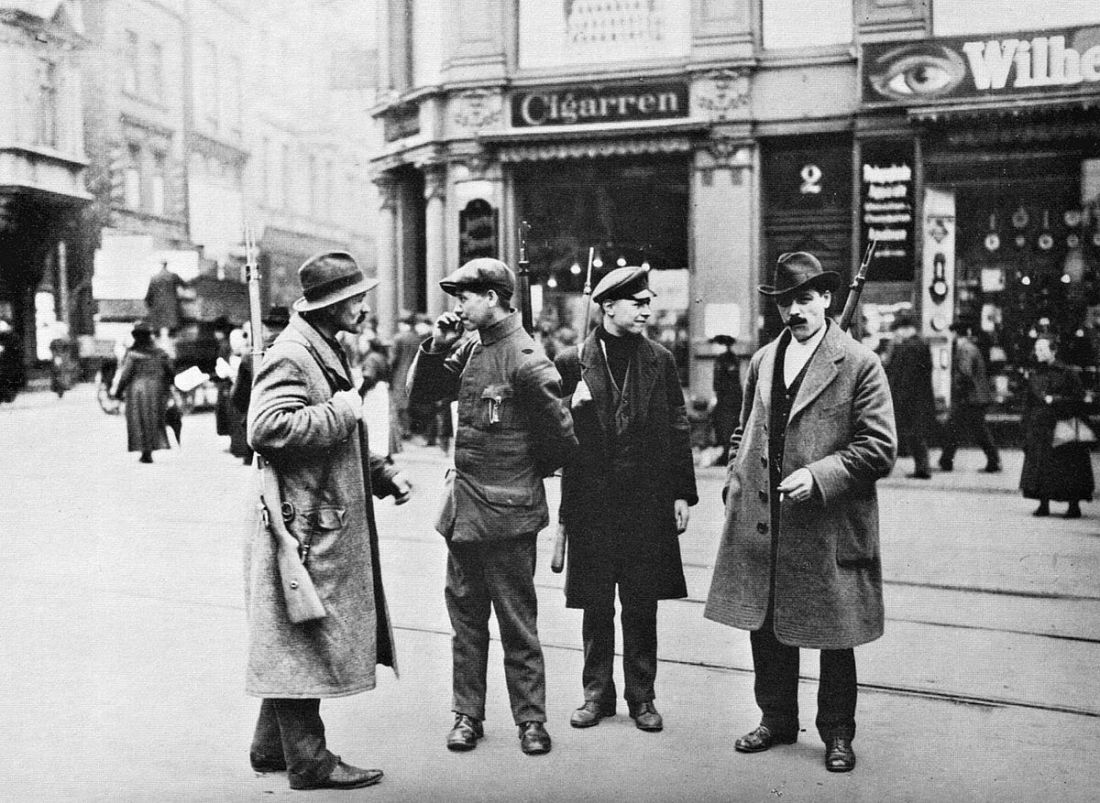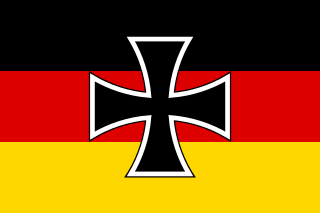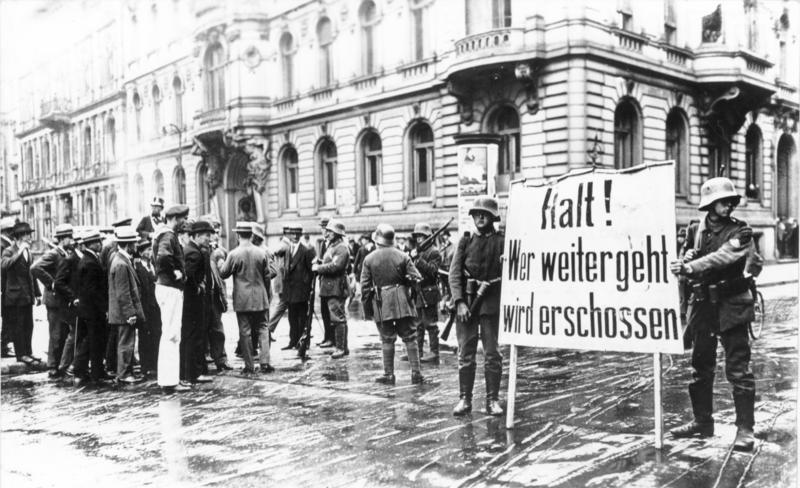
The Ruhr uprising started as a perfectly legitimate civil (mostly workers’) protest against the totally illegitimate Kapp putsch. However, the German Communists (supported, interestingly enough, by various Social Democrats) predictably jumped on this unique opportunity to launch a coup of their own and seize power – at least in the Ruhr region (part of modern-day in North Rhine-Westphalia and now the largest urban area in Germany). And ideally – in the whole Germany.
On March 23th, 1920, the Marinebrigade Ehrhardt (the most potent Freikorps unit) led by von Lüttwitz marched into Berlin, occupied the government buildings and installed Wolfgang Kapp as new chancellor, calling for a return of the monarchy (no less).
Neither Reichswehr nor the police had any desire to interfere (as both were either neutral or outright supportive of the coup) so the Social Democratic government’s only chance to bring down the coup was to call a nationwide general strike hoping that neither German workers nor its civil servants have any desire to return to monarchy that they overthrew just sixteen months earlier.
Allgemeiner Deutscher Gewerkschaftsbund (ADGB) – confederation of German trade unions supported the call for a general strike. Separately, the Communists (KPD), Independent Social Democrats (USPD) and the DDP – the German Democratic Party (well-represented in German governments) also called for a strike.
Government’s assumption was correct – there was little (if any) desire among the workers to do away with the republic and to replace it with the even more authoritarian monarchy than the Second Empire.
So it is no surprise that already on the very first day of the Kapp Putsch twenty thousand workers participated in a demonstration against the coup in just one Ruhr city – Bohum.
However, the national government was in for a big surprise (which actually should have been no surprise at all). In a matter of hours, the “medicine” (strikes and left-wing demonstrations) turned out to be not much better than the “disease” (the Kapp Putsch).
In some key aspects, it was even worse. On March 14th (the next day after the beginning of the putsch in Berlin), KPD, USPD and (surprise, surprise), regional chapter of SPD met in Elberfeld (now a subdivision of Wuppertal) and decided on a spontaneous alliance against the putschists.
With the ultimate objective (explicitly stated in their joint appeal) of… “winning political power by the dictatorship of the proletariat”. In practical terms, it was the call for another coup (a “counter-coup”, if you will). The Red one. The uprising.
The call was enthusiastically answered by local workers’ organizations who immediately began to form “Executive Councils” and take over political power across the whole Ruhr area.
These councils were predictably dominated by USPD and KPD with the active participation of representatives of anarcho-syndicalist Free Workers’ Union of Germany (FAUD) – an independent (from ADGB) trade union.
Two key differences made the “medicine” far worse than the “disease”. First, it got a military support from a 50,000 strong Red Ruhr Army (RRA) formed in a matter of a day on March 13th (the Marinebrigaden Ehrhardt that single-handedly occupied Berlin and ousted the national government had only 6,000 soldiers).
Second, unlike the Kapp Putsch that had no public support whatsoever, the Ruhr uprising could potentially count on support of millions of workers not just in the area but in the whole Germany.
300,000 mine workers (about 75% of the work force in mining) immediately proclaimed their support for the RRA. The national government was justifiably afraid that the uprising was a beginning of a full-scale Russian-style Communist revolution.
Not surprisingly, the mighty RRA in a very short time prevailed over the undermanned local government (police and Reichswehr) forces. The national government had no other choice than to… send in Freikorps units not that different from the ones who were involved in the Kapp Putsch.
On March 17th, RRA units attacked an advance party of the Freikorps Lichtschlag under Hauptmann Hasenclever. The Reds took the enemy force’s weapons, captured 600 Freikorps soldiers and occupied Dortmund, meeting little if any resistance.
Energized by these military successes, on March 20th in Essen, spontaneous leaders of the uprising formed the Central Committee of the Workers’ Councils which was supposed to serve as the de-facto provisional government of the region. Which by the end of March was firmly under the control of these councils.
By that time, the Kapp Putsch has already collapsed and on March 22nd the government, the unions and the parties (KPD, USPD, SPD and DDP) announced the end of the general strike. Having successfully defeated the “black coup”, the national government was now ready to take care of the Red one.
On March 24th, the government issued an ultimatum demanding that the workers’ councils put an end to the strike and the uprising by 30 March – or Ruhr will be occupied by the Reichswehr who will put an end to the uprising with a military force.
The RRA was a military force far superior to Freikorps units; however, it was no match for a Reichswehr. Consequently, the leaders of the uprising took this threat very seriously and agreed to start negotiations with the government.
Negotiations began on the same day – March 24th – in the city of Bielefeld. An agreement was reached which gave the chance for a peaceful end to the uprising. Unfortunately, some local leaders as well as the RRA commanders rejected the agreement preferring an “honorable downfall” to a “dishonorable surrender”.
Which predictably led to a new ultimatum issued this time by the military authorities – regional military commander Generalleutnant Oskar von Watter. Determined to crush the uprising with brutal force, he intentionally made it impossible to comply with.
The Essen Workers’ Council no less predictably called for a new general strike supported by over 300,000 miners. This gave von Watter the excuse for sending his troops (augmented by Freikorps units) to the area on April 2nd .
Crushing the uprising turned out to be not a walk in the park as von Watter expected. Despite their overwhelming technical superiority, his units lost 208 dead and 123 missing. Freikorps losses amounted to 173 dead.
RRA lost about 1,100 dead; however as everyone carrying weapons at the time of their arrest were shot—including the wounded – battlefield losses were roughly about even.
Reichspräsident Ebert issued an order that forbade these summary executions on April 3rd – the next day after von Watter’s troops entered Ruhr. However, the latter ignored it and issued a similar order only on April 12th when the uprising was completely crushed.
Invasion of Ruhr that was supposed to be demilitarized according to the Versailles Treaty did not make the Allies very happy (to put it mildly). Hence, on April 6th the French Army occupied Frankfurt, Hanau and Darmstadt, creating essentially a safe haven for the RRA (which promptly fled there).
The British occupation forces were threatening to occupy the Bergisches Land in reprisal for the blatant violation of the Treaty of Versailles by the Reichswehr and thus forced the latter to stop at the river Ruhr. However, by April 8th it was in full control over the whole Northern Ruhr area. The Ruhr uprising was over.
Adolf Hitler who undoubtedly followed the Ruhr events closely (he was an avid reader of all major German newspapers), made the following inevitable conclusions.
Yes, the Communists will seize any opportunity to obtain the power in a German region and in the whole Germany via an armed uprising and the general strike. Yes, it is all a Bolshevist conspiracy (KPD was a member of the Moscow-based Comintern, after all). And yes, it is all a part of a global Jewish conspiracy to grab the power in Germany – and ultimately to destroy it.
The latter (totally erroneous) conclusion was based on, alas, indisputable historical facts. Hugo Haase, the founder and the first Chairman of the Independent Social Democratic Party of Germany that played a leading role in the uprising (and subsequently joined Comintern), was a Jew.
He was also a co-chairman of the Council of the People’s Deputies – the government of the November Revolution in Germany from November 1918 until February 1919.
It was the Council that negotiated the armistice with the Allies on November 11, 1918. Which made Haase one of the “November criminals” in the eyes of Adolf Hitler and the November revolution – a part of a Jewish plot to destroy Germany.
Paul Levi, then chairman of the Communist Party of Germany that also played an important role in the uprising (and was already a member of Comintern) was a Jew. As was Hugo Preuss – a prominent Social Democratic politician and the author of the Weimar Constitution (the latter fact made the whole Weimar Republic a part of a global Jewish conspiracy in Hitler’s eyes).
 Weimar Republic died (believe it or not, but from completely natural causes) and was replaced by Nazi Germany (i.e. the Third Reich) for one and only one fundamental reason.
Weimar Republic died (believe it or not, but from completely natural causes) and was replaced by Nazi Germany (i.e. the Third Reich) for one and only one fundamental reason. Germany’s descent into the abyss of hyperinflation began with an ominous sign – assassination of Reich Finance Minister Matthias Erzberger on August 26th, 1921. Political murder was almost an everyday thing in Weimar Republic at that time (only the right-wing extremists committed 354 assassinations in 1919-22) but even by those standards murder of a finance minister was way out of the ordinary.
Germany’s descent into the abyss of hyperinflation began with an ominous sign – assassination of Reich Finance Minister Matthias Erzberger on August 26th, 1921. Political murder was almost an everyday thing in Weimar Republic at that time (only the right-wing extremists committed 354 assassinations in 1919-22) but even by those standards murder of a finance minister was way out of the ordinary.
